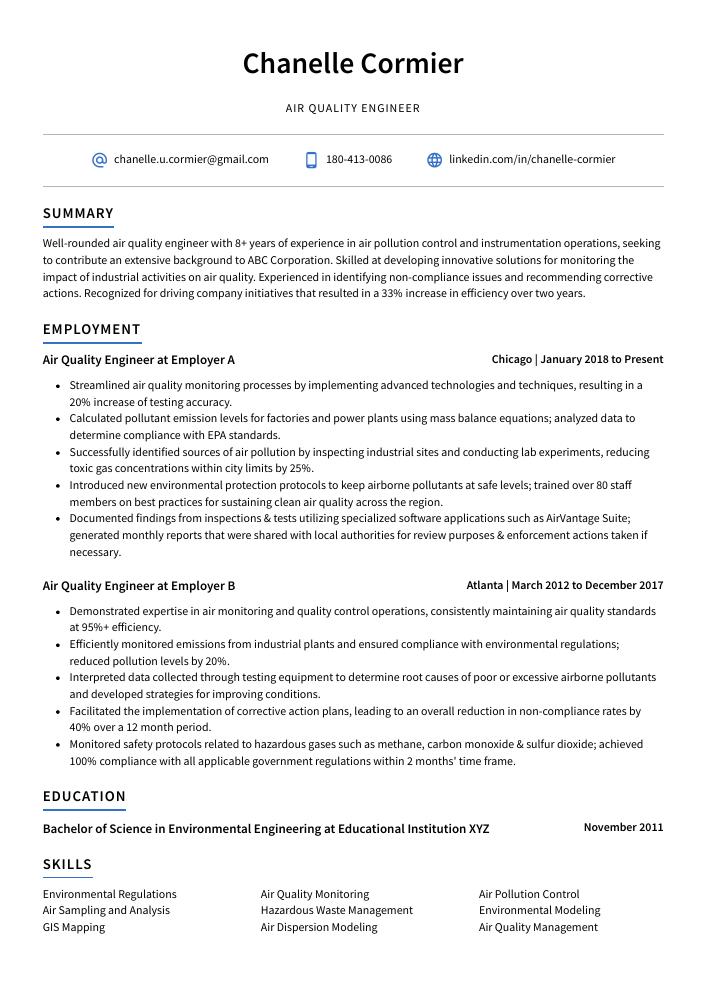Air Quality Engineer Resume Guide
Air Quality Engineers monitor and analyze air quality data to ensure that environmental regulations are met, develop strategies for improving air quality, and design systems or processes to reduce pollution. They also work with other engineers, scientists, and technicians to create solutions that limit the amount of pollutants in the environment.
With your extensive knowledge of air quality and the environment, you’d be a great asset to any environmental organization. But they don’t know who you are yet—so make sure to create an attention-grabbing resume that convinces them to hire you!
This guide will walk you through the entire process of creating a top-notch resume. We first show you a complete example and then break down what each resume section should look like.
Table of Contents
The guide is divided into sections for your convenience. You can read it from beginning to end or use the table of contents below to jump to a specific part.
Air Quality Engineer Resume Sample
Chanelle Cormier
Air Quality Engineer
[email protected]
180-413-0086
linkedin.com/in/chanelle-cormier
Summary
Well-rounded air quality engineer with 8+ years of experience in air pollution control and instrumentation operations, seeking to contribute an extensive background to ABC Corporation. Skilled at developing innovative solutions for monitoring the impact of industrial activities on air quality. Experienced in identifying non-compliance issues and recommending corrective actions. Recognized for driving company initiatives that resulted in a 33% increase in efficiency over two years.
Experience
Air Quality Engineer, Employer A
Chicago, Jan 2018 – Present
- Streamlined air quality monitoring processes by implementing advanced technologies and techniques, resulting in a 20% increase of testing accuracy.
- Calculated pollutant emission levels for factories and power plants using mass balance equations; analyzed data to determine compliance with EPA standards.
- Successfully identified sources of air pollution by inspecting industrial sites and conducting lab experiments, reducing toxic gas concentrations within city limits by 25%.
- Introduced new environmental protection protocols to keep airborne pollutants at safe levels; trained over 80 staff members on best practices for sustaining clean air quality across the region.
- Documented findings from inspections & tests utilizing specialized software applications such as AirVantage Suite; generated monthly reports that were shared with local authorities for review purposes & enforcement actions taken if necessary.
Air Quality Engineer, Employer B
Atlanta, Mar 2012 – Dec 2017
- Demonstrated expertise in air monitoring and quality control operations, consistently maintaining air quality standards at 95%+ efficiency.
- Efficiently monitored emissions from industrial plants and ensured compliance with environmental regulations; reduced pollution levels by 20%.
- Interpreted data collected through testing equipment to determine root causes of poor or excessive airborne pollutants and developed strategies for improving conditions.
- Facilitated the implementation of corrective action plans, leading to an overall reduction in non-compliance rates by 40% over a 12 month period.
- Monitored safety protocols related to hazardous gases such as methane, carbon monoxide & sulfur dioxide; achieved 100% compliance with all applicable government regulations within 2 months’ time frame.
Skills
- Environmental Regulations
- Air Quality Monitoring
- Air Pollution Control
- Air Sampling and Analysis
- Hazardous Waste Management
- Environmental Modeling
- GIS Mapping
- Air Dispersion Modeling
- Air Quality Management
Education
Bachelor of Science in Environmental Engineering
Educational Institution XYZ
Nov 2011
Certifications
Certified Indoor Air Quality Professional
American Council for Accredited Certification
May 2017
1. Summary / Objective
A resume summary/objective is a great way to give employers an overview of your air quality engineering experience and qualifications. In this section, you can highlight the most relevant skills that make you stand out from other candidates. For example, mention any certifications or awards related to air quality engineering that you have earned, as well as any successful projects or initiatives in which you played a key role. Additionally, emphasize how your expertise has enabled organizations to meet their environmental goals and regulations.
Below are some resume summary examples:
Detail-oriented air quality engineer with 5+ years of experience in monitoring, analyzing, and evaluating air pollution data. Skilled at conducting field studies to assess the impact of industrial activities on ambient air quality. Experienced in developing strategies for compliance with relevant environmental regulations and standards. At XYZ Corporation, reduced emissions by 40% through process optimization initiatives while ensuring regulatory compliance across 12 states.
Dependable Air Quality Engineer with 5+ years of experience in the field. Specialized knowledge in environmental regulations, air pollution monitoring and control technologies, health risk assessment techniques, and sustainable energy solutions. At XYZ Company conducted over 300 successful air quality studies for a variety of clients in various industries. Received recognition from customers for consistently delivering high-quality results on time.
Enthusiastic Air Quality Engineer with 5+ years of experience in the industry. Skilled at designing and implementing air quality monitoring systems that meet environmental regulations. At XYZ, led a team to develop an automated system for collecting air pollution data from remote locations; saved $100k/year in labor costs for the company. Effective communicator who can collaborate well with stakeholders across multiple departments.
Skilled air quality engineer with 5+ years of experience in environmental health and safety. Skilled at performing air pollution measurements, assessing the impacts of new projects on existing ecosystems, reviewing permit applications for compliance with standards, and developing action plans to reduce emissions. Seeking a role at ABC Technologies to help create cleaner environments through responsible engineering practices.
Reliable and detail-oriented Air Quality Engineer with seven years of experience in the environmental engineering industry. Proven track record of successful implementation and maintenance of air quality standards for various public, private, and commercial sites. Committed to ensuring compliance with regulations while delivering cost-effective solutions that protect human health and natural resources.
Energetic air quality engineer with 5+ years of experience in environmental engineering. Skilled at developing and executing strategies to reduce emissions from industrial sources, optimize energy consumption, and ensure regulatory compliance. At XYZ Energy Solutions, successfully developed a sustainable air pollution control system that led to an 11% reduction in emissions over a period of two years.
Diligent air quality engineer with 7+ years of experience in environmental engineering. Proven track record of developing and implementing systems to reduce air pollution, improve efficiency, and ensure compliance with regulations. Currently looking for a role at ABC Company that would allow me to use my expertise to create clean-air strategies that will benefit the environment and community.
Proficient air quality engineer with 8+ years of experience in designing and analyzing systems to improve air quality. At XYZ, improved safety by implementing new regulations that reduced hazardous emissions by up to 15%. Seeking an opportunity at ABC Corporation where I can use my technical expertise and analytical skills to help the company achieve its environmental sustainability goals.
2. Experience / Employment
For the experience section, you should list your work history in reverse chronological order, with the most recent job listed first.
When writing about what you did for each role, use bullet points to make it easier for the reader to take in the information quickly. Be sure to provide detail and include quantifiable results whenever possible.
For example, instead of saying “Conducted air quality tests,” you could say, “Performed daily air quality testing utilizing a handheld device that measured particulate matter levels; identified three areas where pollution exceeded EPA standards and implemented solutions that resulted in an average reduction of 20%.”
To write effective bullet points, begin with a strong verb or adverb. Industry specific verbs to use are:
- Monitored
- Analyzed
- Investigated
- Evaluated
- Reported
- Designed
- Implemented
- Inspected
- Operated
- Collected
- Assessed
- Calculated
- Interpreted
- Researched
- Documented
Other general verbs you can use are:
- Achieved
- Advised
- Compiled
- Coordinated
- Demonstrated
- Developed
- Expedited
- Facilitated
- Formulated
- Improved
- Introduced
- Mentored
- Optimized
- Participated
- Prepared
- Presented
- Reduced
- Reorganized
- Represented
- Revised
- Spearheaded
- Streamlined
- Structured
- Utilized
Below are some example bullet points:
- Collected, analyzed and reported on air quality data from over 15 sites in the region, leading to a 12% reduction in airborne pollutants.
- Implemented innovative strategies that improved production processes and reduced hazardous emissions by 25%.
- Spearheaded projects to evaluate current environmental regulations for compliance with government standards; recommended updates and changes resulting in an increase of 10% compliance rate among facilities within five months.
- Substantially decreased energy consumption levels at industrial plants through the implementation of efficient technologies, saving $10K per month across all sites combined.
- Evaluated various aspects of air pollution control systems such as fuel storage tanks, boilers, cooling towers & scrubbers for proper operation; identified areas requiring improvement which increased operational efficiency by 14%.
- Competently assessed air quality in over 50 industrial settings, identifying potential environmental health hazards and recommending cost-effective solutions to reduce emissions by 25%.
- Coordinated with stakeholders from diverse background such as regulatory agencies, industry representatives and local communities to develop strategies for improving air quality standards.
- Represented the organization at meetings with external clients; generated $4 million worth of business opportunities in six months through successful negotiations with key partners.
- Researched and analyzed data from various sources including field samples and laboratory tests to monitor pollutant levels across multiple sites; provided detailed reports on findings that were instrumental in developing new operational procedures for factories within the region.
- Developed innovative approaches for controlling harmful emissions which resulted in a reduction of airborne pollutants up to 80% compared to previous standards set by the EPA over a period of 12 months.
- Formulated and implemented air quality improvement strategies for an industrial plant, resulting in a 15% reduction of emissions and pollutants.
- Meticulously monitored the concentration levels of gaseous pollutants at various sites to ensure compliance with regulatory standards; identified potential hazardous sources early on and took appropriate preventive measures.
- Mentored 3 junior engineers in assessing air pollution risk and creating effective solutions that met environmental goals while minimizing operational costs by up to 10%.
- Optimized existing equipment performance through data analysis which led to lower energy consumption rates across all production areas over 6 months period; achieved savings of $5,000 per month on average.
- Utilized sophisticated software such as SCRAMBLER & AIQDSensors to analyze real-time changes in ambient air quality parameters like temperature, humidity, visibility etc., ensuring maximum safety at site locations throughout the year.
- Expedited development and implementation of air quality regulations to improve standards by 40% in 5 months.
- Achieved top-level compliance with government agencies on over 100 pollution control projects; reduced emissions by 15%.
- Compiled technical reports analyzing current air quality conditions, identifying areas for improvement, and recommending corrective actions that decreased contamination levels by 8%.
- Structured comprehensive environmental monitoring programs to assess potential health risks associated with local industrial activities; successfully lowered hazardous chemical exposure rates from 25 ppm to 10 ppm within 2 years.
- Accurately collected data using advanced sampling methods such as emission spectroscopy and gas chromatography/mass spectrometry (GCMS) analysis procedures; prepared 35+ detailed test results each month for higher management review.
- Improved air quality standards by 20% through the installation of specialized filtration systems to reduce emissions in industrial areas.
- Reorganized existing processes and procedures to ensure compliance with local, state and federal regulations; successfully avoided costly penalties for non-compliance.
- Inspected equipment operations at multiple work sites to identify potential health risks posed by air pollutants; enabled a safer working environment for employees while reducing overhead costs by $5,000 per quarter.
- Developed detailed reports on air pollution trends across various industries and issued recommendations on how best to improve current policies regarding emission control measures; increased public safety awareness about the impact of poor air quality on human health & well being significantly over time.
- Independently tested indoor air samples from homes and businesses using advanced carbon dioxide analyzers equipped with real-time data logging capabilities; identified hazardous particles present in the atmosphere within 2 hours or less after each inspection was completed.
- Effectively managed air quality engineering projects with a total budget of $500,000+, ensuring compliance to relevant laws and regulations.
- Advised 20+ municipal governments on ways to reduce carbon emissions through efficient energy management and waste disposal practices, resulting in an overall reduction of 8%.
- Prepared detailed reports for clients regarding indoor/outdoor air quality assessments; developed action plans that addressed key areas of concern such as hazardous pollutants or airborne toxins.
- Revised building codes related to ventilation systems in order to enhance the safety & healthiness of occupants in commercial spaces; improved efficiency by 10% while reducing energy consumption costs by 15%.
- Reduced instances of environmental contamination from industrial sites within designated regions through comprehensive monitoring initiatives and risk analysis assessment efforts during project execution stages.
- Designed and implemented air quality monitoring protocols and strategies to improve the local environment, resulting in a 10% reduction of emissions.
- Operated sophisticated laboratory equipment to test atmospheric samples for presence of pollutants; identified areas most vulnerable to pollution and took necessary action accordingly.
- Presented findings from air quality research studies at professional conferences, workshops and seminars across 5 states; published 3 papers on environmental health-related topics in peer-reviewed journals.
- Resourcefully devised cost-effective solutions that improved the overall efficiency of existing environmental management systems by 15%.
- Analyzed current trends in urban air pollution levels using statistical software packages such as SAS & SPSS; developed guidelines for risk assessment & hazard control practices based on results obtained from data analysis activities.
- Investigated and monitored air quality throughout the region, analyzing emissions from industrial sources and motor vehicles to identify potential contaminants; lowered local ozone levels by 10%.
- Participated in long-term studies of regional air pollution trends, collecting data over 3 years and presenting findings to scientific community at conferences across the country.
- Thoroughly evaluated existing regulations regarding ambient air quality standards for various pollutants and worked with governmental agencies on policy recommendations that improved public health outcomes by 15%.
- Reported results of environmental monitoring activities in a timely manner using sophisticated testing equipment including gas chromatographs, spectrophotometers and particle counters; increased accuracy rate of measurements by 20%.
3. Skills
Skill requirements will differ from employer to employer – this can easily be determined via the job advert. Organization ABC may be looking for an engineer with experience in air quality monitoring, while organization XYZ may require someone who is knowledgeable about emissions control technology.
It is important to tailor the skills section of your resume to each job you are applying for because many employers use applicant tracking systems these days. These programs scan resumes for certain keywords before passing them on to a human recruiter or hiring manager; therefore, it pays off if you include the relevant ones that appear in the job description.
You can further elaborate on your skill set by discussing it more thoroughly in other areas such as work history and summary sections.
Below is a list of common skills & terms:
- Air Dispersion Modeling
- Air Pollution Control
- Air Quality Management
- Air Quality Monitoring
- Air Sampling and Analysis
- Environmental Auditing
- Environmental Modeling
- Environmental Regulations
- GIS Mapping
- Hazardous Waste Management
4. Education
Including an education section on your resume will depend on how far along you are in your career. If you just graduated and have no work experience, mention your education below the objective statement. However, if you have significant work experience to showcase, omitting an education section is perfectly fine.
If an education section is included, try mentioning courses related to air quality engineering or environmental science that could be beneficial for the job position being applied for.
Bachelor of Science in Environmental Engineering
Educational Institution XYZ
Nov 2011
5. Certifications
Certifications can be a great way to demonstrate your expertise in a certain field. They show potential employers that you have taken the time and effort to become certified, which can give them confidence in your abilities.
When writing up this section of your resume, make sure to include any certifications related to the job you are applying for as it will help prove that you possess the necessary knowledge and skills required for success.
Certified Indoor Air Quality Professional
American Council for Accredited Certification
May 2017
6. Contact Info
Your name should be the first thing a reader sees when viewing your resume, so ensure its positioning is prominent. Your phone number should be written in the most commonly used format in your country/city/state, and your email address should be professional.
You can also choose to include a link to your LinkedIn profile, personal website, or other online platforms relevant to your industry.
Finally, name your resume file appropriately to help hiring managers; for Chanelle Cormier, this would be Chanelle-Cormier-resume.pdf or Chanelle-Cormier-resume.docx.
7. Cover Letter
Providing a cover letter with your job application is a great way to stand out from the competition. This document, which consists of 2 to 4 paragraphs, allows you to explain why you are an excellent fit for the role and provides recruiters with more information about who you are as a professional.
Cover letters aren’t usually required but writing one gives employers greater insight into your skillset and experience. It also helps them get to know your personality better so that they can make informed decisions when assessing candidates for the position.
Below is an example cover letter:
Dear Stella,
I am interested in applying for the Air Quality Engineer position at [company name]. I am a civil engineer with 4+ years of experience working on air quality projects. I have a strong background in environmental engineering and air pollution control, and I am confident that I can be an asset to your organization.
In my previous role as an Air Quality Engineer at [company name], I was responsible for leading air quality monitoring programs and conducting emissions inventories. I also developed air quality models to predict pollutants concentrations, advised clients on permit compliance issues, and prepared technical reports. My experience has given me a deep understanding of the principles of atmospheric science, dispersion modeling, meteorology, and emission sources.
I am knowledgeable about state and federal regulations related to air pollution control, including the Clean Air Act Amendments of 1990. I am also familiar with various computer software programs used for data analysis, such as Excel, Access, and SQL. In addition to my technical skills, I have excellent communication and interpersonal skills that will enable me to work effectively with clients and other stakeholders.
I believe that my skills and experience make me an ideal candidate for this position. I look forward to discussing how I can contribute to your organization in further detail during an interview.
Sincerely,
Chanelle
Air Quality Engineer Resume Templates
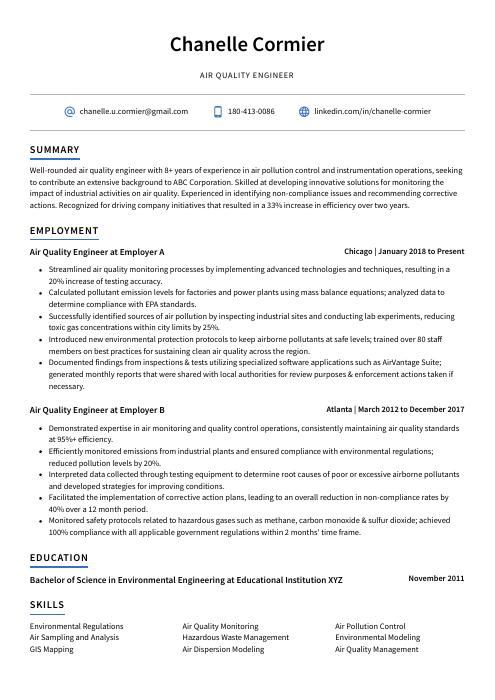 Axolotl
Axolotl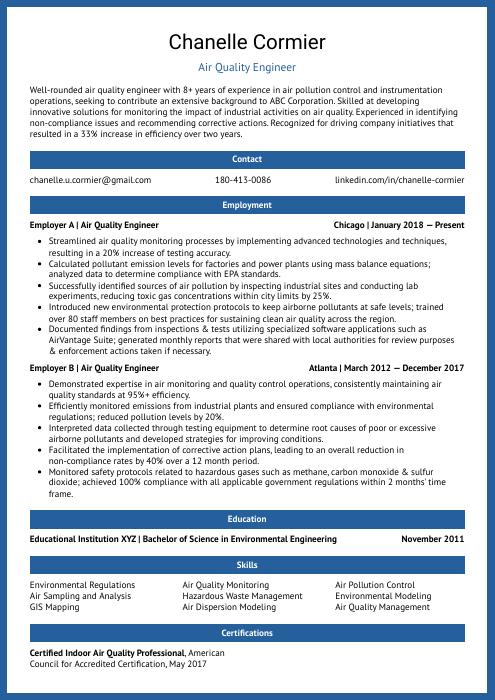 Ocelot
Ocelot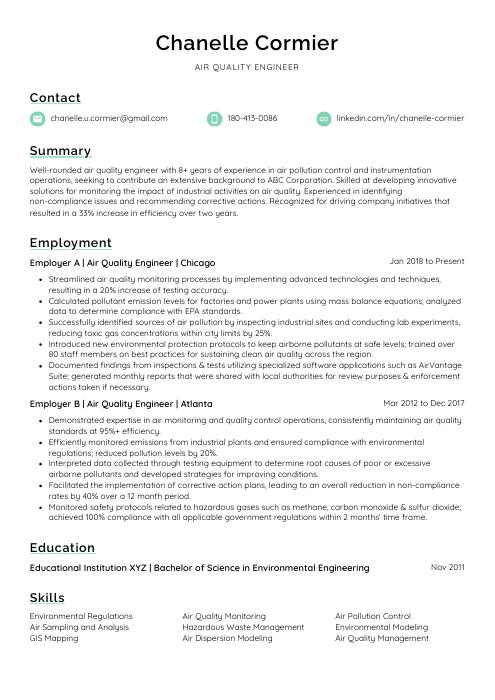 Lorikeet
Lorikeet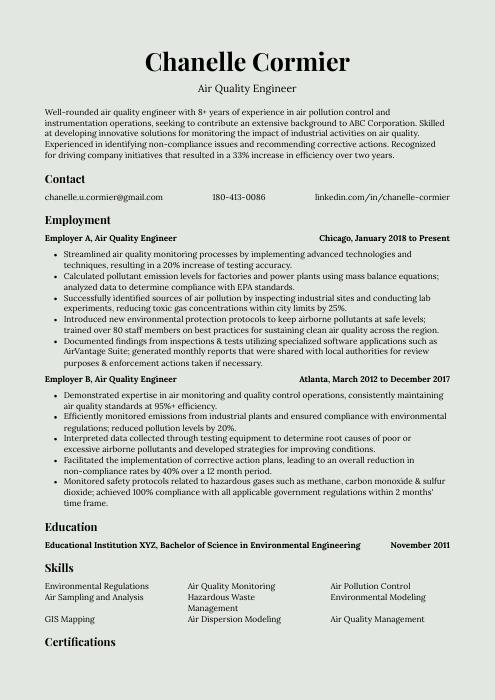 Saola
Saola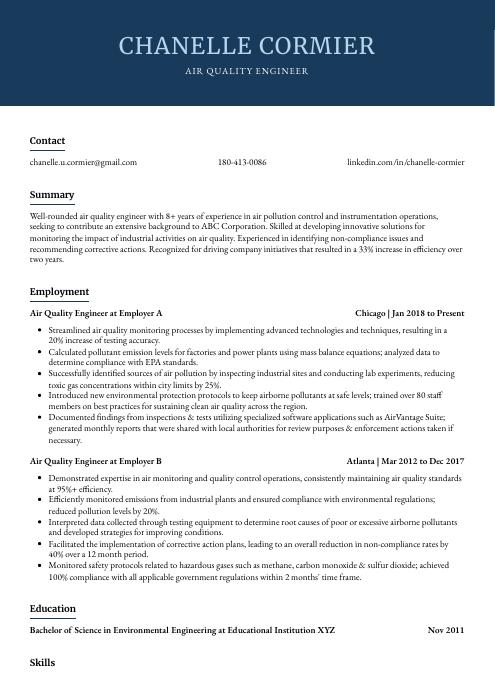 Bonobo
Bonobo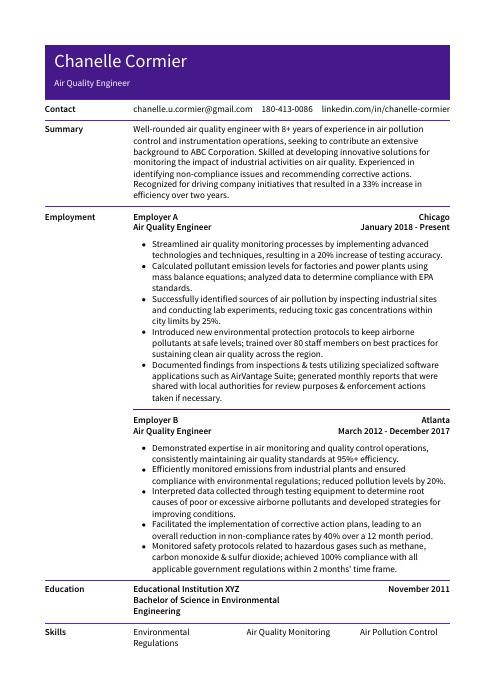 Pika
Pika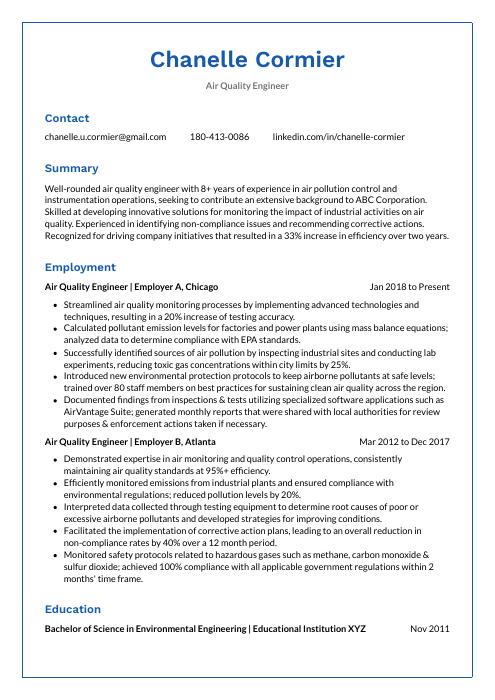 Markhor
Markhor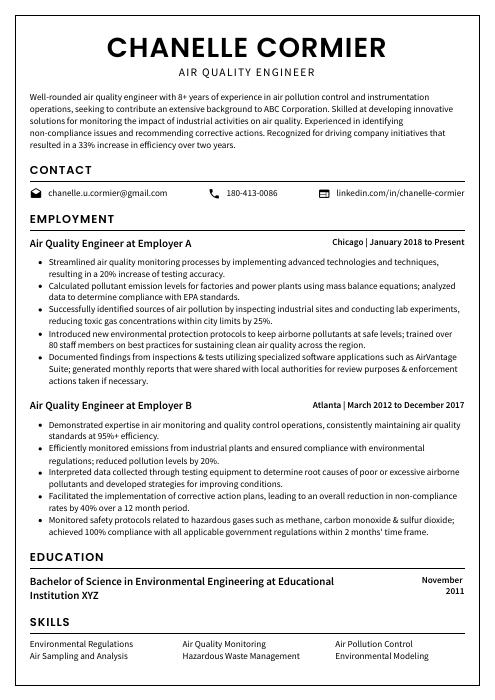 Cormorant
Cormorant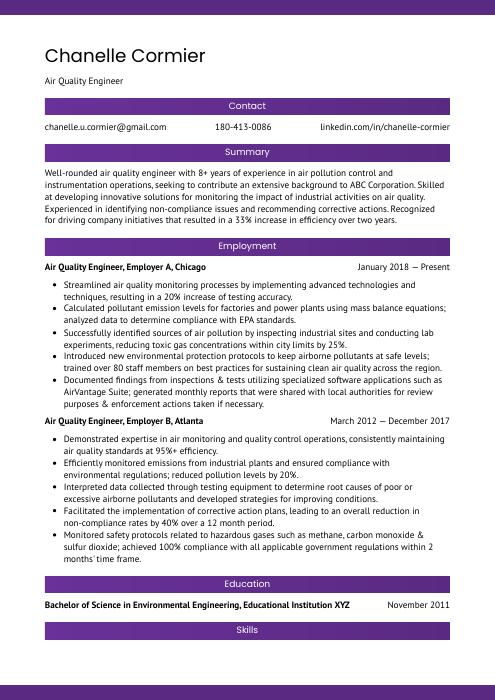 Jerboa
Jerboa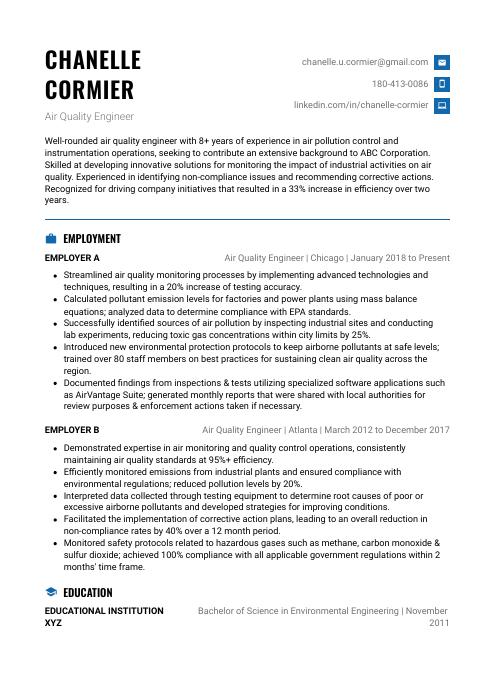 Echidna
Echidna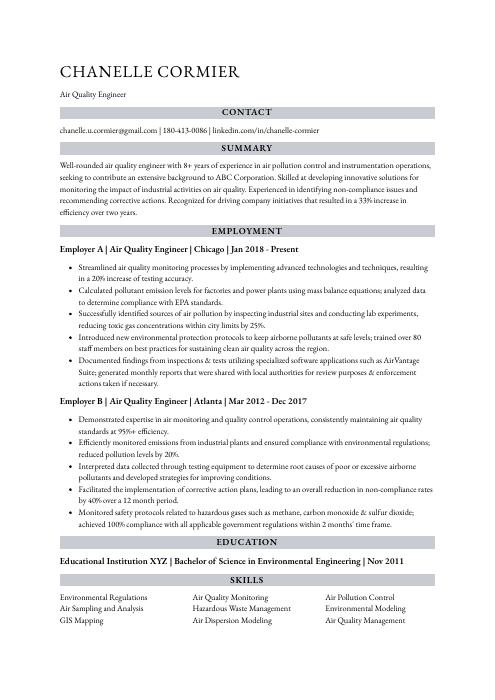 Numbat
Numbat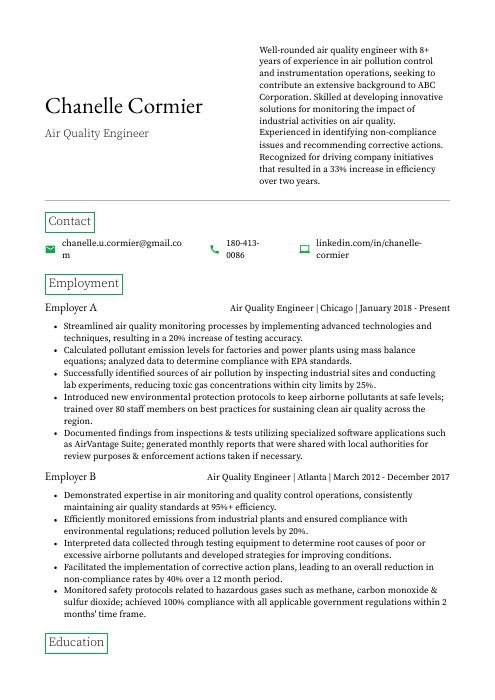 Quokka
Quokka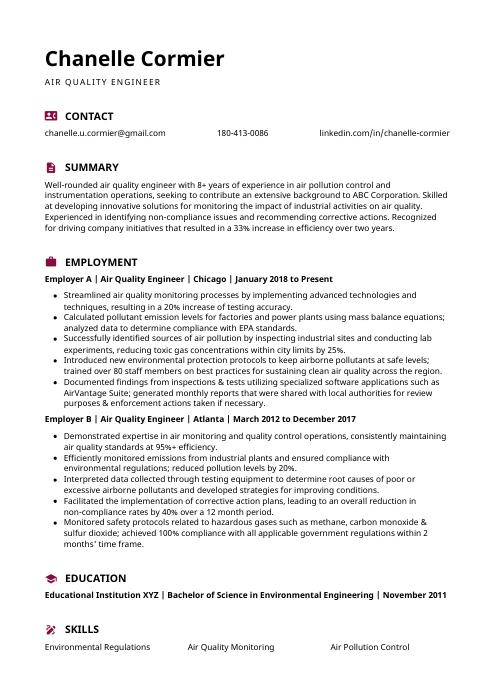 Hoopoe
Hoopoe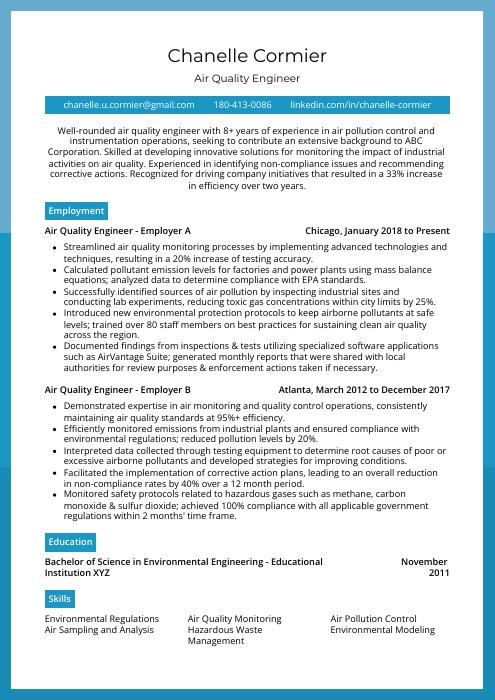 Rhea
Rhea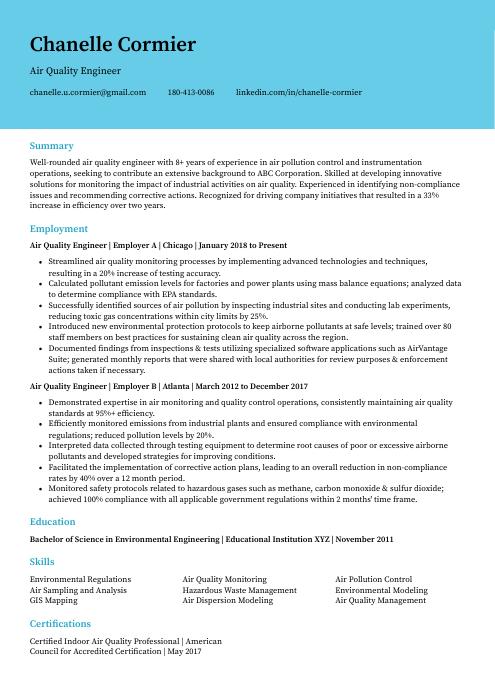 Dugong
Dugong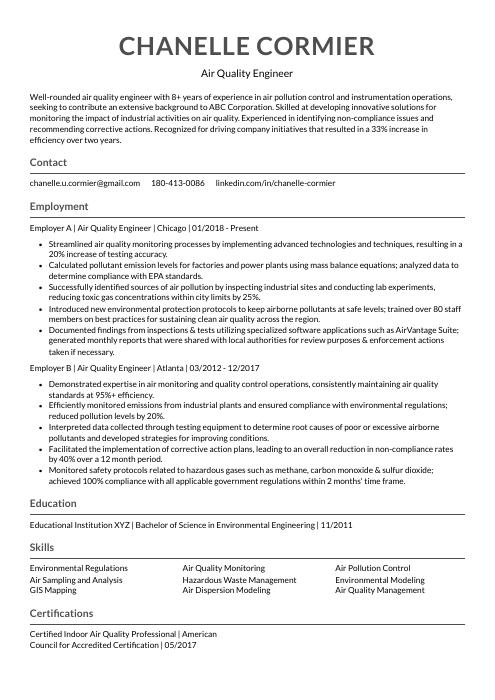 Indri
Indri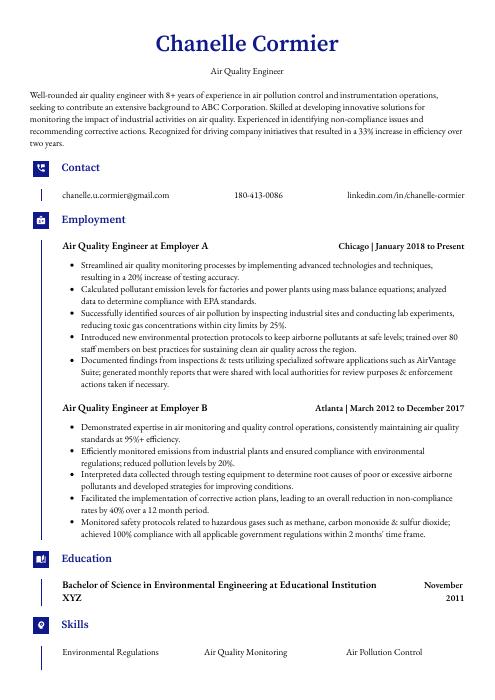 Gharial
Gharial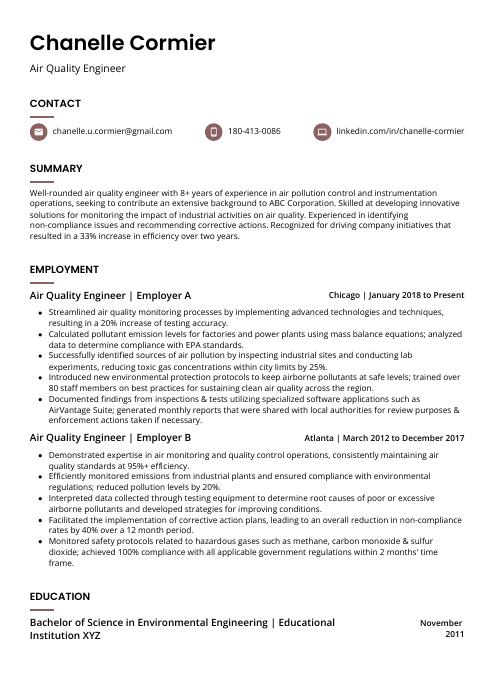 Fossa
Fossa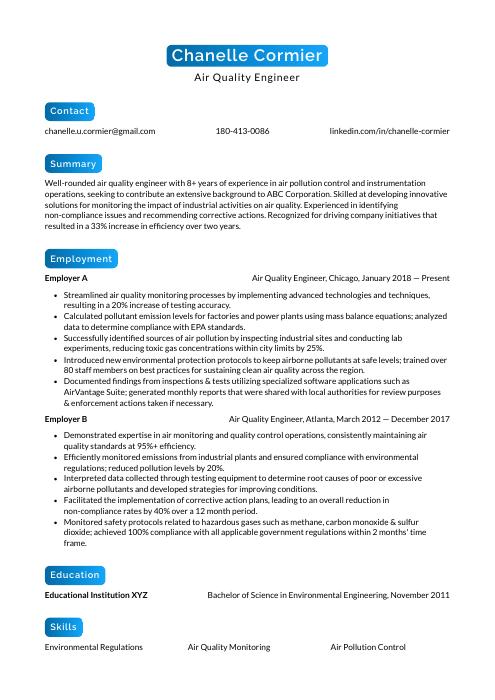 Kinkajou
Kinkajou Rezjumei
Rezjumei
